

Simon Bradbury of Impressions Games reflected that a key decision to continue with sequels to Caesar was that Ancient Rome contained a "wealth of material for a strategy game.there's a lot of epic history which I think a lot of people can easily identify with". Developer David Lester cited initial hesitation to pursue a third sequel as " Caesar II had been so well-received that we didn't know where to take it.there were points we had considered and discarded for Caesar II that we could add, but they wouldn't amount to a new product." After six months of development, the designers returned to Ancient Rome as a setting for the project. The game that would become Caesar III was initially conceived by Impressions Games as a city-building game set in space. The editor was also distributed with later releases of the game. The editor allows players to produce their own scenarios from over twenty city locations, as well as choosing the identity of invaders, available buildings, and features on the map itself.
CAESAR 3 WINDOWS 7 PATCH DOWNLOAD
The game menu also provides access to a map of the Empire to facilitate trade and identify threats from enemy invasions.įollowing release, Sierra made available for download a map editor for the game on their website. These include a chief advisor, who summarizes key information and critical issues, as well as advisors that provide statistics and options for the provision and coverage of most services in the game, including labor, health, education, trade and religion.
CAESAR 3 WINDOWS 7 PATCH SERIES
Players are provided with a series of advisors who can help them with various aspects of city life.


Favor ratings are measured by whether players fulfil in a timely manner the requests from Caesar to pay a tribute or provide gifts. Peace ratings rise so long as no damage is caused by crime, riots, or invasion. Prosperity takes into account factors such as employment rates, housing quality, and revenue. Culture ratings are measured by the coverage of 'culture buildings' (such as temples, theaters, and schools) in a city. Progress in Caesar III is evaluated against the population of a city and four ratings: Culture, Prosperity, Peace and Favor. Ī screenshot from Caesar III depicting its isometric perspective gameplay. In addition, different areas of terrain generate different resources and obstacles, including river channels, fertile land, and mining areas. Caesar III also features inhabitants that provide services to buildings by walking past them, adding an additional element of strategy to road pathing. In Caesar III, all actions occur on a single map, in contrast to the province and city maps of its predecessor. Caesar III features significant changes to its predecessor, Caesar II. Players are required to manage several interconnected supply chains in order to sustain the growth of their city, which increases as more needs are met, including the supply of water, food, religious services, entertainment, education, and health. Buildings are selected from an interface under submenus categorized by building type. Gameplay in Caesar III involves the construction of cities on a map displayed in a two dimensional isometric perspective. Military assignments include the risk of enemy invasion, whilst peaceful assignments contain more stringent requirements for victory, and additional challenges including earthquakes, fires and other hazards. Players are given a choice at the beginning of each assignment to play a map that is 'peaceful' or 'military'. Assignments are set over time in historical Roman cities, such as Brundisium and Londinium. The Career mode of Caesar III follows a series of branching assignments requiring players to construct cities of increasing size and complexity. Caesar III features two modes of play: 'Career', in which players follow a progression of assignments of increasing difficulty with conditions for success, and the 'City Construction Kit', an open-ended mode without victory conditions.


 0 kommentar(er)
0 kommentar(er)
